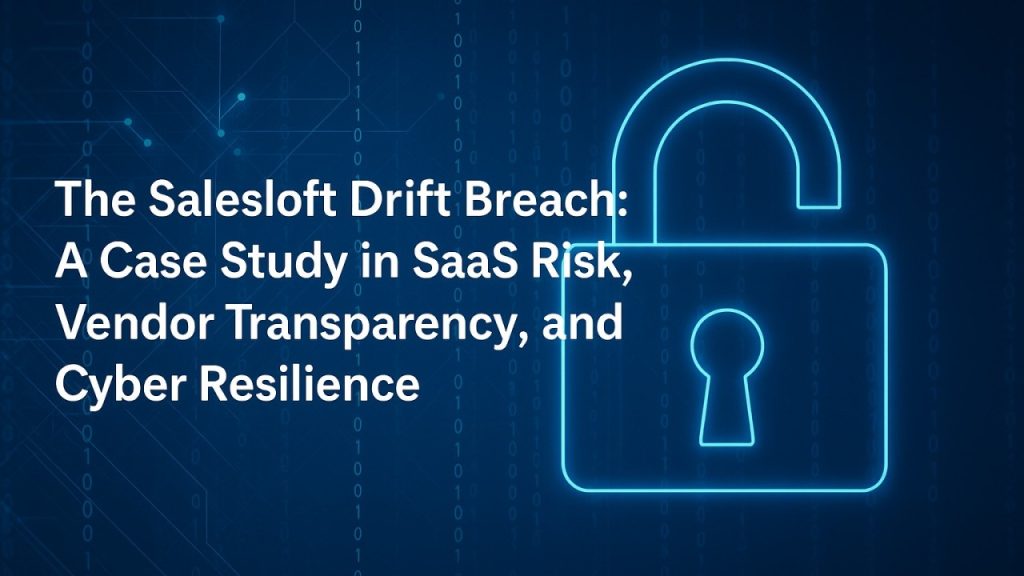The Salesloft Drift Breach: A Case Study in SaaS Risk, Vendor Transparency, and Cyber Resilience

US Service Center
September 6, 2025
by Andre Leroux September 6, 2025
In the age of AI-driven automation and cloud-based integrations, the recent breach involving Salesloft’s Drift chatbot has become a stark reminder of the hidden risks lurking in our SaaS supply chains. This incident didn’t just affect one company—it rippled across a network of integrations, exposing sensitive data and challenging assumptions about trust, access, and accountability.
What Happened: A Breach Beyond the Surface
Salesloft, a provider of AI-powered chatbots and sales engagement tools, disclosed a breach in its Drift application that allowed attackers to steal OAuth tokens—digital keys that grant access to connected services. These tokens weren’t limited to Drift; they unlocked access to platforms like Salesforce, Slack, Google Workspace, AWS, and others.
The breach was discovered by Google’s Threat Intelligence Group (GTIG), which attributed the attack to a threat actor known as UNC6395. Between August 8 and August 18, 2025, the attackers used these stolen tokens to infiltrate Salesforce instances across multiple organizations. Importantly, this wasn’t a vulnerability in Salesforce itself—it was a case of valid credentials being misused, making the attack harder to detect and more damaging.
Cloudflare’s Response: A Blueprint for Transparency
Among the affected companies was Cloudflare, which published a detailed incident report outlining how the breach impacted their systems and what steps they took in response. The attackers accessed Cloudflare’s Salesforce support case data, which included customer contact information, configuration details, and in some cases, credentials shared during troubleshooting.
Cloudflare’s response was swift and comprehensive:
- Revoked all affected tokens and rotated credentials across integrated platforms.
- Disconnected all third-party Salesforce integrations, including Drift.
- Notified impacted customers and provided guidance on next steps.
- Launched a company-wide incident response, including forensic analysis and security reviews.
- Implemented weekly credential rotations for all sensitive integrations going forward.
Their transparency and accountability set a high standard for how vendors and enterprises should respond to supply chain breaches.
The Bigger Picture: SaaS Supply Chain Risk
This incident highlights a growing challenge in cybersecurity: the complexity and opacity of SaaS integrations. Many organizations rely on dozens—sometimes hundreds—of third-party tools that plug into core systems like Salesforce, Google Workspace, and AWS. Each integration introduces potential risk, especially when OAuth tokens are used to grant broad access.
What makes this breach particularly concerning is the nature of the attack. The threat actor didn’t exploit a software vulnerability—they used legitimate credentials to move laterally across systems. This kind of “credential hijacking” is increasingly common and difficult to detect, especially when tokens are long-lived and permissions are overly broad.
Lessons for Security Leaders and SaaS Users
- Audit Your Integrations Regularly Know which third-party apps have access to your core systems. Map out the data flows and permissions granted to each tool.
- Limit Token Lifespans and Scope Use short-lived tokens and restrict access to only what’s necessary. Avoid granting full administrative access unless absolutely required.
- Monitor API Behavior Unusual API calls—especially those involving data exports or credential access—should trigger alerts and reviews.
- Demand Transparency from Vendors Cloudflare’s incident report is a model for how vendors should communicate during a breach. Ask your vendors how they plan to respond if their systems are compromised.
- Treat SaaS Like Infrastructure Just because a tool is “plug-and-play” doesn’t mean it’s low-risk. SaaS platforms should be governed with the same rigor as your cloud infrastructure.
Final Thought: Security Is a Shared Responsibility
The Salesloft Drift breach isn’t just a cautionary tale—it’s a call to action. As organizations continue to embrace AI, automation, and cloud-native tools, the boundaries of responsibility must evolve. Security teams must extend their visibility into third-party integrations, vendors must prioritize transparency, and executives must understand that trust in technology is earned—not assumed.
This incident reminds us that in today’s interconnected digital landscape, your security posture is only as strong as your weakest integration. Let’s use this moment to rethink how we manage SaaS risk, how we choose our vendors, and how we respond when things go wrong.
Looking to strengthen your SaaS security posture?
At US Service Center, we help organizations audit, secure, and monitor their third-party integrations—before they become liabilities. Let’s talk about how we can help you build resilience into your digital supply chain.
#CyberSecurity #SaaS #DataProtection #IncidentResponse #CloudSecurity #Salesloft #Drift #Cloudflare #OAuth #SecurityLeadership #DigitalTrust #USServiceCenter
